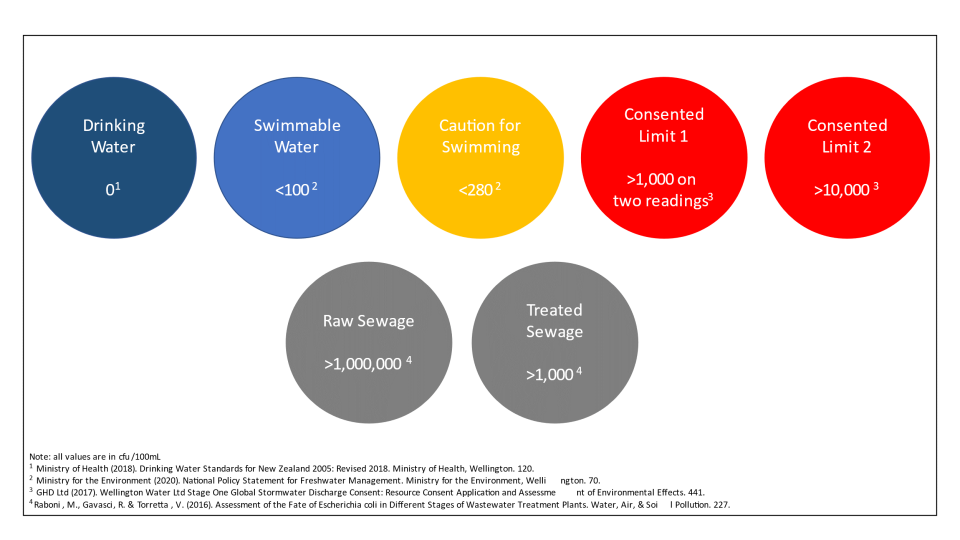Owhiro Bay catchment sampling
The Owhiro Stream originates in the suburb of Brooklyn, flowing down through Happy Valley before being released into Owhiro Bay on the south coast of Wellington. There are two main tributaries of the stream, the first originating in Kowhai Park and the second at Careys Gully. The total stream length in the catchment is approximately 26km. Pre-settlement the Owhiro Stream catchment would have been heavily forested on the hillslopes, with areas of coastal scrubland near the south coast. By the early 1900’s large deforestation had occurred, with stock being grazed in the area, and the residential areas being established by the 1920s (Blaschke, 2012).
In present day the Owhiro Stream catchment contains a mixture of residential, industrial, and natural/vegetated areas. The Owhiro Stream remains one of the only water courses on Wellington’s south coast to be largely open channel, with only a few areas being piped under the surface.
The stream is graded as Wai Kino, contaminated by human waste in the Te Oranga Wai Mana Whenua assessment framework (2021). Owhiro Bay is also classified as an area of significance to Mana Whenua in the Te Whaitua te Whanaganui-a-Tara Implementation Programme (2021). Water quality indicators have been classified from A through to E in the Whaitua Implementation Programme, which gives an overview of any issues in the area. The Owhiro Stream catchment is within the Wellington Urban sub-catchment, which has rankings of an E for E.coli, D for Copper, B for Zinc, and D and B for clarity and deposited sediment respectively. Although these water quality indicators are for the whole of the Wellington Urban catchment they give an overview of the likely water quality issue facing the Owhiro Stream.
Map Legend
Loading
Water quality routine sample testing - how it's reported
We take regular samples of water quality to look into the level of E.Coli for freshwater and Enterococci for marine waters, which indicate whether the water is safe for swimming and other recreational activities.
The way in which we test and classify when water is safe, or not safe depends on how the stream or waterway is classified (i.e. either as a ‘consented stormwater discharge’, or a Marine and Freshwater recreational area). Find out more about our reporting requirements below:
Consented stormwater discharge
The Owhiro Stream is a freshwater watercourse that is covered under a resource consent approved by the Greater Wellington Regional Council (GWRC) for stormwater discharge.
The consent requires us to monitor stream water quality on a monthly basis at three designated sites, Owhiro Bay beach, below T&T Landfill, and upstream of the Owhiro Bay Parade Bridge. The consent also requires us to undertake an investigation if the routine E.coli monitoring at either of these sites identifies a single result >10,000cfu/100mL or two successive monthly E.coli results >1,000cfu/100mL. These investigations are only initiated if the sample was not influenced by rainfall, which is cross checked with the rain gauge at Shandon Golf Club.
In addition to this, GWRC undertakes monthly Rivers Water Quality and Ecological (RWQE) monitoring upstream of the Owhiro Bay Parade Bridge . There are no investigation triggers associated with this programme.
Marine and Freshwater Recreational Areas
Owhiro Stream is not classified as a Freshwater Recreational Area, however the beach is classified as a Marine Recreational Area
For areas classified as a Marine and Freshwater Recreational Areas, Enterococci sample readings equal to or less than 140 cfu/100 mL, or Equal to or less than an E.coli level of 260 cfu/100mL give a suitable for swimming classification. Where a Enterococci reading is greater than 140 / 100mL, or more than an E.coli level 260 cfu/100mL, the area is given a Caution Advised classification. Finally, where an Enterococci reading is more than 280cfu/100mL, or more than an E. coli level of 550 cfu/100 mL, it is given an unsuitable for swimming classification.
These classifications are recorded and reported by LAWA (Land, Air, Water Aotearoa) and made available through their website).
E.coli rule of thumb guide (In development - will be updated)

Report an issue
If you believe this relates to a specific consent, please reference that consent number
Hotline
Greater Wellington Regional Council Pollution Hotline
0800 496 734
